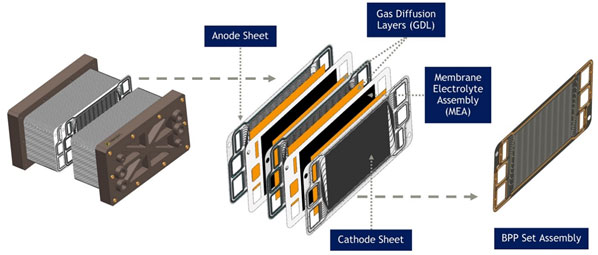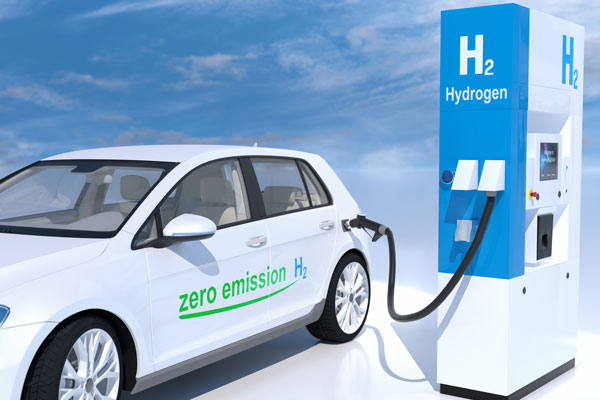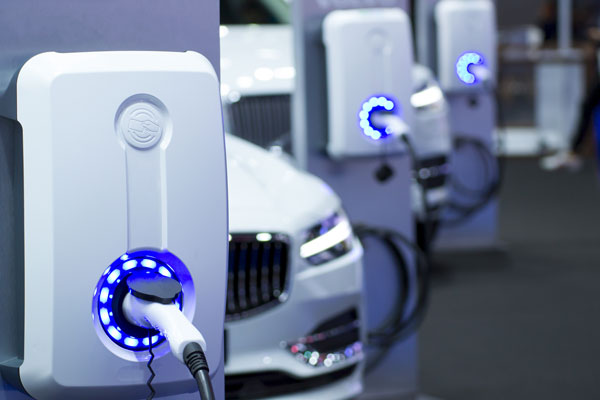Overview
As the electric vehicle (EV) and overall electrified transportation sectors continue to mature, the roles of various technologies are becoming clearer. This Flash Facts update focuses on how hydrogen fuels cells fit into the technology landscape and provide important complementary capabilities alongside other electrification approaches.
Quick Overview of Hydrogen Fuel Cells
The type of fuel cell that is most applicable for transportation applications is the polymer electrolyte membrane (PEM) fuel cell. In a PEM fuel cell, an electrolyte membrane is sandwiched between a positive electrode (cathode) and a negative electrode (anode). Hydrogen is introduced to the anode, and oxygen (from air) is introduced to the cathode.
Hydrogen molecules break apart into protons and electrons due to an electrochemical reaction in the fuel cell catalyst. Protons then travel directly through the membrane to the cathode. Electrons travel through a circuit to provide power for external applications, before recombining with the protons on the cathode side where the protons, electrons, and oxygen molecules combine to form water.
Multiple bipolar plates (BBPs) are combined to within a PEM Fuel Cell to provide the required level of electrical energy production, in much the same way that multiple cells in a battery are combined to deliver specified output levels. As shown below, fuel cells have a Membrane Electrolyte Assembly (MEA) and Gas Diffusion Layer in between BPPs.

ENNOVI has worked closely with fuel cell makers throughout the transportation industry to optimize the multiple components that combine to form each BBP, where precision design and consistent assembly are critical for success.
Fuel Cell Applications in Electrified Transportation
Fuel Cell Electric Vehicles:

Fuel cell electric vehicles (FCEVs) combine hydrogen stored in an onboard tank with oxygen from the air to produce electricity, with water vapor as the only by-product. The most common type of fuel cell for vehicle applications is the polymer electrolyte membrane (PEM) fuel cell. The electricity from the fuel ceil is then used to power the vehicle’s electric motor.
Refueling is fast and simple if there are available hydrogen refueling stations. FCEVs can be quickly refueled with hydrogen in much the same manner that conventional cars are refueled with gasoline. However, there currently is no widespread infrastructure of hydrogen refueling stations, which severely limits FCEV consumer adoption, especially outside of a few urban environments that have focused on developing hydrogen refueling options.
Fuel Cell Powered Public Transportation:

A growing number of jurisdictions such as transit authorities, school districts, delivery services, and others are turning to hydrogen fuel cell powered buses, trucks, and vans. Because such vehicles typically return to a central location at the end of each shift, the hydrogen refueling process can be optimized in that location rather than having to rely on a network of refueling stations.
Fuel cells are also considered a viable solution for other transport applications such as trains, barges, and some trucking applications where the vehicles are large enough to carry sufficient hydrogen fuel onboard to avoid the need for frequent refueling stations along the routes being traveled.
Industrial, Warehouse and Factory Floor Fuel Cell Applications:

Similarly, many localized transport applications that occur within warehouses, factories or larger campus environments can make use of fuel cell powered vehicles because they can be easily refueled at stations throughout the facility or campus.
Specific applications include hydrogen powered forklifts, materials transport carts, and intra-building campus shuttles. Many organizations are already achieving significant savings and reducing their carbon footprints with such localized applications.
Expanding EV Charging Infrastructures with Fuel Cell Charging Stations:
Another very exciting opportunity that is gaining traction is the use of hydrogen fuel cell stations to generate the electricity for charging battery electric vehicles (BEVs). Most industry analysts point out that lack of widespread charging infrastructures is likely to impede the rate at which consumers adopt BEVs for their personal transportation requirements.
In addition, there is a rising concern that existing power grids are not sufficient to accommodate rapid growth of BEVs. With most power grids already straining to adequately serve homes and businesses, the addition of millions of BEVs plugged into garages and other grid-powered charging stations could push existing power grids beyond their capacities.
Hydrogen fuel cells have the potential to solve both the grid capacity limitations and the lack of geographic availability issues surround EV charging stations.

There are a number of industry collaborations and initiatives already underway around the world with the aim to combine fuel cell power generation with fast-charging EV technologies that in combination can eliminate the constraints of existing grid limited EV charging infrastructures.
According to a spokesperson for one such Israel-based partnership, “As the number of electric vehicles increases, the demand for a wide network of distributed EV charging stations will grow exponentially. On the one hand, forecasts indicate that grid power will not be sufficient to power the estimated quantity of EVs that will reach the roads, and on the other, many destinations to which EVs will need to travel will be beyond the power grid. In both of these scenarios, autonomous off-grid EV charging stations powered by hydrogen… will be a key solution.”
Summary
Although the majority of media and consumer attention regarding next-gen vehicle electrification has focused on the rapidly growing EV market, the achievement of global decarbonization across the entire transportation spectrum will require an “all of the above” technology approach.
While it is unlikely that in the near term, we will see a widespread proliferation of hydrogen-powered consumer vehicles, there are many applications where hydrogen fuel cell technology will provide a critical enabling factor for overall success and cost-effective electrification of transportation systems.
ENNOVI is proud to have played a vital enabling role in the EV revolution by designing technologies used in powertrains, batteries, power modules and other key onboard systems.
At the same time, we have been instrumental in the evolution of hydrogen fuel cells, including design of Bipolar Plates and other critical enabling technologies.
In combination, these advanced technologies will help eliminate the use of fossil fuels and reduce carbon emissions throughout the globe, thereby helping mitigate the impacts of climate change and enable a greener, healthier world.
For more information about solutions for hydrogen fuel cells technologies and next-gen EVs, visit ENNOVI at www.ennovi.com or drop us an email at communications@ennovi.com.
